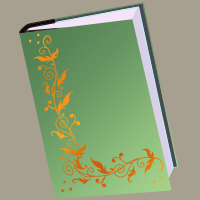Feb 04, 2024
" All the world is a theater [...] and all our lives we play many roles." (Shakespeare ).
Here, the world is represented by the April of its days - the verdant garden - lost in the middle of winter, a lifeless biome.
Yet it is life that links these two worlds.
Winter is a time when life pauses, frozen while spring is a time when life begins anew. In winter, people can contemplate their life's work - to savor all its facets or regret not having built or passed on more - and better realize their condition, their human nature. Then comes spring, a symbol of renewal and hope, when spirits are inflated by new dreams and resolutions: life resumes its course in the frost of time.
So there can be no spring without winter, and vice versa - the two are inextricably linked.
Outside the monastery, Velan is immersed in an sempiternal winter where fear and death have stopped life in its tracks. There, time runs its course but seems to have frozen. The population is a mass of anxiety, humans who walk and think : a mass of people rather than individuals, whom history has turned into prey, somehow depriving them of all humanity. The monastery, on the other hand, is a place where time has stood still, where life follows its course in its most beautiful days, in an eternal springtime.
On the other hand, Velan is winter in the sense that it's here that everyone realizes their so called "human condition". A human condition that is inherent in everyone: for most humanity means prey, for Omen it's universal, for Aelem it's something she craves, her springtime. And from this realization flow a number of resolutions: to save oneself by protecting oneself, to protect others in order to save, and to flee in order to protect oneself
And all these resolutions have one thing in common: living.
Then come the spring : the monastery, the embodiment of renewal and these resolutions. A place whose purpose is to sustain life, to push back this terrifying "winter" as far as possible - to perpetuate the beauty of the world it contains beyond its walls.
( To this end, if the city is the faded side of the fence and the monastery the verdant exterior, then isn't sitting in the middle of this garden a step on the other side of that fence for Aelem? )
Unfortunately, blood can stain the most beautiful flowers. In this garden, our puppets with knight's masks train to kill, to take away the life they want so much to protect.
They perform an ode to life using death.
An ode in which Aelem is a spectator. A spectator watching calmly, with eyes full of curiosity, as the puppets move before her eyes.
In this piece, she contemplates a new form of life, an "artificial" life embodied by the automaton.
Then if living is seen as simply walking and thinking ( in a persona/peoples perspective ) then what differentiates it from a human being? The color of its blood? The seams under his clothes? Absolutely nothing because in this case it is just "acting", like everyone else in this place, like all those empty dolls.
Nevertheless , for the moment, these subtleties (fighting techniques/their "stage names") distinguish them from each other as "actors". In other words, far from being individuals, they are distinct "personas".
The mask of happiness being the most difficult mask to wear, even the most talented actor can let it slip - in spite of himself.
Smiling as if his humanity depended on it, the "mask of happiness" is a burden that the "butterfly Knight" wears on his face.
Defending oneself doesn't just mean raising arms or shedding blood, using the power of words to kill. In "life", there are different ways of defending oneself, and smiling is one of them. A smile, a burst of laughter can shine in the darkness, bring warmth to the heart and, more generally, bring a little humanity into a world devoid of it.
Perhaps that's why "The butterfly knight" is smiling, rather than killing.But what about Omen as an individual?
Before it became a symbol of rebirth, renewal and evolution, admired for its beauty by all, the butterfly was a caterpillar inspiring disgust and horror: a monster devoid of beauty. Before hatching, the butterfly had to survive, build its cocoon and wait.
A bit like Omen, perhaps. His smile would be his butterfly wings, wings that everyone admires, but wings that make him suffer because the pain of unfolding them - his past - is still raw.
Beyond that, the process of hatching is akin to the logic of the seasons: sometimes a harsh winter is necessary for the most beautiful flowers to bloom in spring. In this case, harsh winter would be Omen's past - and the achievements that flow from it - and spring the future he's trying to build by planting better flowers of peace with the help of his smile.
Omen performs spring while a cold wind still blows across his heart, stuck in the middle of winter.
What an interesting character.
Oki now it's time for some constructive criticism. While the chapter itself is- as usual- pretty good, some moments of the narrative tend to fall into rapid enumeration rather than "invigorating" description of the action. I'll just quote these "passages" and explain what I mean.
- when Lace mentions Omen's father. Since the smile is one of his defining features, the mere mention of it fading in an instant was more than enough to show the deleterious side of their relationship/Omen's negative expression. As a result, it was not really necessary to add that "his gaze grew shadowed, and his eyes sharpened as he looked back at Lace". Especially as you then emphasize the cold, unnerving tone of his voice + his furrowed gaze a little later => which already subtly finishes unraveling his "new mask". At this point, "as he looked towards lace" could have been mentioned when he replies (like for example "he spoke in a cold, unnerving tone, as he looked back towards Lace" ), making the scene a little more fluid/natural.
- "the automaton that had fallen to the ground began to whir once again, its foot shaking against the grass impatietly. Its began to prop itself up, standing headless before the Knights. In unison, they turned to meet its missing expression".Here "its began to prop itself up, standing headless beford the Knights" cuts the rhythm of the passage a little, and we fall back on the purely "enumerative" aspect of the action. His whirring and his footing already presupposed some movement on his part, so there was no need, in my opinion, to indicate right away that he was standing up. Rather, it would have been wiser to include the idea that he's getting up when the knights turn towards him, for instance by stating "In unison, they turned to meet his headless body slowly proping up" or something like that. This creates a fluid transition between the two scenes without giving the impression of going from one thing to another too quickly.
- when omen fights the automaton . "Omen pulled his blade from his side and parried the sword of the automaton in a way that a resounding ring echoed in throughout the garden. He then pierced it through its steel abdomen and allowed it to fall to the ground in a heap of metal". The fight itself is pretty well portrayed, but once again there was room for a more natural transition between the moment when he parries his blow and the moment when he thrusts the sword into its body to get rid of this "enumerative" effect. What I find interesting in this passage is that you emphasized the sound of their swords clashing, so why not reuse this idea of "sound" to describe the action that follows? In the same way that life regained its body earlier, it could have left it with a whirring sound, its body falling little by little, to finally be nothing but a heap of metal. From a symbolic point of view, this would be a nice parallelism, and would go a little way towards this life/puppet concept (but at this point it's just my overthinking brain speaking). We'd go from an "action/sound/action/action" schema to "action/sound/sound/action", making the whole thing more balanced.
![]()



